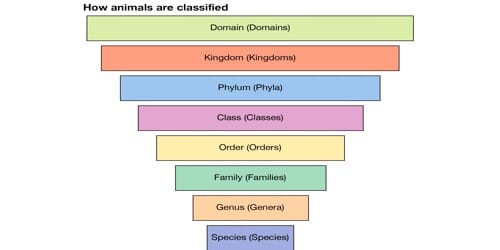There are certain steps for the classification of the plant kingdom. These steps are called Taxa and are singular Taxon. A taxon is a group of organisms that are classified as a unit. Using the steps classification is to be done ICBN or International Code of Botanical Nomenclature is the International constitution for naming the plants. Seven main steps are recognized by ICBN. Species and orders are both examples of taxonomic ranks, which are relative levels of grouping organisms in a taxonomic hierarchy. These are:

Domain – A domain is the utmost (most general) rank of organisms. Taxonomic ranks are always capitalized, except for species. This allows people to distinguish between bacteria (the organisms; could refer to all bacteria or just two definite bacteria) and Bacteria (the domain, which includes all bacteria).
- Kingdom: The plant kingdom is composed of the whole number and types of plants present in the world. The plant kingdom is comprised of about 450000 species. There is no set agreement on the kingdom classification, and some researchers have abandoned it altogether. In the past, the different kingdoms were Animalia, Plantae, Fungi, Protista, Archaea, and Bacteria.
- Division: The Plant Kingdom is divided into seven Divisions. There are 35 phyla (division) in the kingdom Animalia, including Chordata (all organisms with a dorsal nerve cord), Porifera (sponges), and Arthropoda (arthropods).
- Class: Each division is divided into several classes. The class was the most general rank proposed by Linnaeus; phyla were not introduced until the 19th Century. Today’s classes of plants are different than the ones Linnaeus used, and classes are not frequently used in botany.
- Order: Each class is divided into several orders. There are between 19-26 orders of Mammalia, depending on how organisms are classified sources differ. In animal’s families, Felidae and Canidae are included in the same order Carnivora.
- Family: Each order is divided into several families. Some families in the order Carnivora, for example, are Canidae (dogs, wolves, foxes), Felidae (cats), Mephitidae (skunks), and Ursidae (bears). In-plant Classes with a few similar characters are arranged in a higher category of Division.
- Genus: Each family is divided into several Genera (PI. of Genus). It is the first part of an organism’s scientific name using binomial nomenclature; the second part is the species name. The scientific name for humans is Homo sapiens. Homo is the genus name, while sapiens is the species name.
- Species: Each genus is divided into several species. Species is the most particular major taxonomic rank; species are sometimes divided into subspecies, but not all species have multiple forms that are different enough to be called subspecies. There are an estimated 8.7 million different species of organisms on Earth, but the vast majority has yet to be discovered and categorized.
There are about 250000 fruit producing plants. The name of the species should be written in small letters. Usually, several members comprise the higher step, e.g. several species constitute a genus and several genera constitute a family, etc. Sometime only one member of a Taxon may constitute a higher Taxon. In case of necessity, any unit may be split to sub-unit for which the term sub should be prefixed against the main unit (Taxa), e.g. Sub Order, Sub-Family Sub-Genus, Sub-species, etc.
Examples of Taxonomy
The scientific classification of humans is as follows:
- Domain: Eukaryota,
- Kingdom: Animalia,
- Phylum: Chordata,
- Class: Mammalia,
- Order: Primates,
- Family: Hominidae,
- Genus: Homo,
- Species: sapiens.













